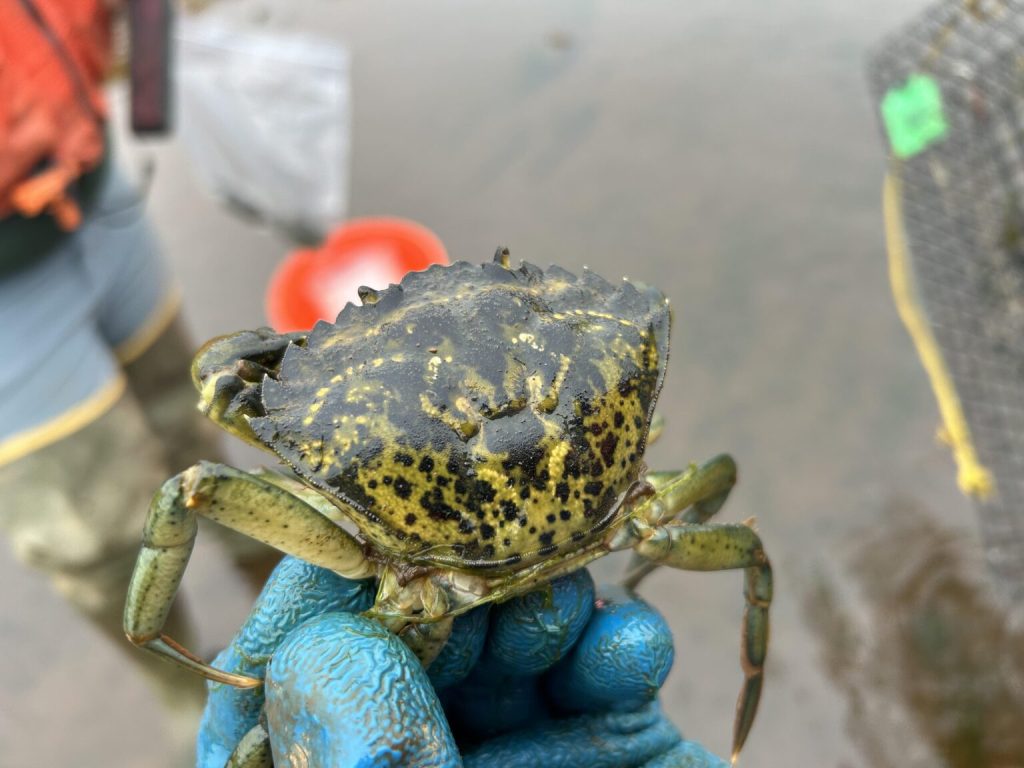Invasive European green crabs have likely found a lasting home in Washington’s coastal waters and parts of Puget Sound.

The question now is whether the state can pinch down hard enough on the aquatic pests to prevent serious harm to native wildlife, shoreline ecosystems, and the commercial shellfish industry. Washington’s Department of Fish and Wildlife, tribes, shellfish growers, and local conservation districts are all taking part in the battle against the unwelcome crustaceans.
“This is one of the rare environmental issues that everybody has, basically, the same goal, which is to see fewer green crabs in Washington,” said Emily Grason, crab team manager at Washington Sea Grant. “It’s brought together a lot of groups that don’t always work together.”
Trapping is the main method in the fight. As of Aug. 4, the Department of Fish and Wildlife said about 905,320 European green crabs have been captured since 2022 — more than 258,888 this year.
“We’re seeing signs of successful green crab population control and progress limiting their spread in Washington’s portion of the Salish Sea, but this invasive species remains prolific in coastal bays, particularly Willapa Bay and Grays Harbor,” Chase Gunnell, an agency spokesman, wrote in an email.
“Sustained heavy trapping will continue to be required in those areas to prevent impacts on clam and oyster growers, native shellfish, and estuary habitat,” he added.
Last year, the Legislature approved about $12 million in the current two-year budget for European green crab management.
The Department of Fish and Wildlife is on track to send a six-year green crab response plan to the Legislature and the governor by October 1. In it, the department is preparing to recommend continued state funding at $12 million per two-year budget cycle. The agency intends to press for federal funding as well.
Fish and Wildlife said in mid-August the crabs had, for the first time, been detected in the Quillayute River estuary near La Push. Chelsey Buffington, who leads the agency’s efforts to deal with the crab, described the discovery as unsurprising given populations to the north in Makah Bay and the south around Grays Harbor and Willapa Bay.
The Quileute Tribe has deployed crab traps around the Quillayute River since 2021 with no green crabs captured.
“Now that we know they are here in the Quillayute River system, our management strategy will need to be revisited,” said Jennifer Hagen, marine policy advisor and a marine biologist with Quileute Natural Resources. “Ultimately our concern is the displacement of native species and species that are of cultural importance to the Quileute Tribe.”
‘It requires getting a break from nature’
European green crabs began spreading on the nation’s eastern seaboard in the 1800s, arriving by ship. They were first found in the late 1980s on the West Coast and began to surge in Washington’s waters about five years ago.
Grason, with Sea Grant, pointed out that, unlike places in the East where the crabs have been around for a century or more, Washington is catching them at an earlier stage. “We have a unique opportunity in terms of our timing with this invasion,” she said.
There are also features of the state’s coastline that offer advantages when combating the crabs.
Still, Grason noted that this past winter was warm, which is favorable for green crabs’ spread and survival. “The folks who are trapping in the coastal estuaries are seeing catch rates at least two to three times what they were this time last year,” she said.
A cold winter – even a cold snap – can kill off crab larvae. Something that helps keep the larvae out of Puget Sound and the Salish Sea more broadly, is that rivers in Washington and British Columbia, including the Fraser, push water near the sea’s surface out the Strait of Juan de Fuca, into the Pacific. Larvae originating on the coast, awash in this top layer of water, are blocked by the westward current. But winter storms can sometimes cause the current to reverse, sweeping the larvae eastward into the Salish Sea.
“Doing anything to try to control the population of green crab requires not only a lot of hard work from people, but it requires getting a break from nature,” Grason said.
There’s evidence showing it’s possible to suppress green crab populations at individual sites. But Grason added: “It is not the case that we believe that we can fully eradicate them” from Washington’s waters. “We’re trying to figure out what the best solutions are for a realistic outcome,” she said.
David Beugli, director of the Willapa-Grays Harbor Oyster Growers Association, said sevens shellfish operations that are part of the group are catching green crabs this month and that the number of growers trapping would be slightly higher in the weeks ahead. Shellfish farmers have played a key role in controlling the crabs, capturing thousands of them. It’s work that mainly happens this time of year and into the fall. In winter, the water is too rough to check traps frequently.

In his region, Beugli said he was aware of some isolated damage to areas with oysters, as well as clam beds, but so far nothing widespread.
Going after the crabs means added work for businesses that can already struggle to find employees. But the consequences of letting them spread could be severe for the industry, as the invaders prey on and can otherwise harm species that shellfish growers harvest.
A green crab can eat 40 half-inch clams a day and can feed on other crabs their own size or young oysters. By digging for food, they can damage eelgrass, estuaries, and marshes. Dungeness crabs, native fish, and some birds could also be at risk from the invasive crabs.
While edible, green crabs are only about fist-sized, not known for their culinary appeal, and are often tossed into soups and stocks if used for cooking.
Beugli credited the state for its efforts. But he also said some shellfish farmers are frustrated and would like to see more support, perhaps a massive trapping push in Willapa Bay. “I just don’t know how we could pull that off,” he said. “It’s kind of a specialized skill to get out there and understand the bay and where to trap. And the farmers know it better than everybody.”
As for how much of a threat the crabs might ultimately be for the industry, he said there are still many unknowns. “We’re keeping the numbers down to levels where environmental damages are not occurring,” he said. “I don’t know what the tipping point will be.”
SOURCE: This article was authored by Bill Lucia of the Washington State Standard part of States Newsroom, a nonprofit news network supported by grants and a coalition of donors as a 501c(3) public charity.
RELATED ARTICLE(S)
Author: Lynnwood Times Contributor









